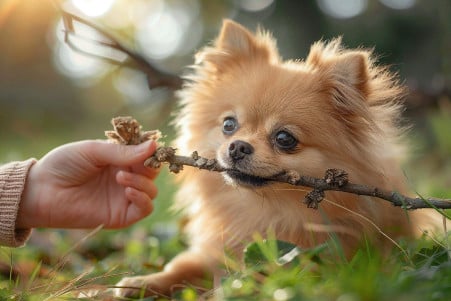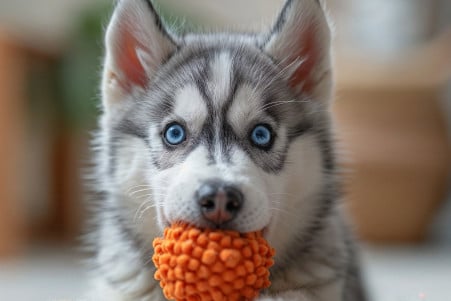Why Do Dogs Like Sticks? The Psychology and Evolution of Stick Love
1 April 2024 • Updated 1 April 2024

Have you ever wondered why your dog is so obsessed with finding, carrying, and chewing on sticks and twigs? It turns out that dogs' love of sticks can be traced back to their days as hunters and scavengers. Sticks are similar in shape and texture to the animals dogs' ancestors hunted and scavenged for, and chewing on them can also satisfy a dog's natural urge to chew. In addition, playing with sticks can also provide dogs with mental stimulation.
In this article, we'll explore why dogs love sticks by looking at the work of animal behaviorists, evolutionary biologists, and veterinarians. These experts have found that the answer to why dogs love sticks lies in the psychology of dogs, their wolf ancestors' predatory behavior, and the mental health benefits of stick-related activities. By learning about the reasons behind this strange but lovable behavior, you can learn to better understand your dog and find ways to help them use their stick obsession in positive ways.
Why do dogs like sticks?
Breed Differences: The Fascinating World of Stick Attraction in Different Breeds
Not all dogs are equally attracted to sticks, and individual differences in stick attraction can be influenced by a dog's breed, age, and past experiences. For example, Dr. Antoinette Martin explains that retrieving breeds like Labradors are more likely to carry sticks to show off their hunting skills or to try to initiate play, while terrier breeds are more likely to shake and dissect sticks, which could be a result of their ancestors' hunting of small prey.
The desire to chase and carry sticks may have originated from wolves' use of sticks in hunting large prey, according to The Science Times. Meanwhile, Poodles or Keeshonds may engage in stick-related behaviors as a way to show off their intelligence, agility, or to engage in other problem-solving activities.
Although the desire to chase sticks is based on dogs' wolf ancestors, as pointed out by Tryfi, breed and individual differences, as well as past experiences, all play a role in determining how much a dog will be attracted to sticks. This natural yet odd behavior sheds light on dogs' hunting instincts and cognitive needs, but it also leads to the potential dangers that dog owners need to be aware of.
Potential Risks and Dangers: How to Keep Your Dog Safe
While dogs' love of sticks may be a natural behavior, the risks associated with this seemingly harmless pastime are anything but. According to Preventive Vet, sticks are responsible for distressing and devastating puncture wounds of the mouth, eyes, abdomen, and even the heart. The American Kennel Club (AKC) also notes that sticks can become lodged across the roof of the dog's mouth, sticking between the teeth on either side of the jaw, and cause ulcers and rotting of the teeth.
In addition to dental damage, dogs may develop a habit of eating rocks or other items, a condition called pica that can be a sign of medical problems or boredom, according to the AKC. Stick-related injuries can be as minor as scratches or as severe as paralysis, excessive blood loss, and life-threatening septicemia, according to multiple veterinary experts.
Veterinarians have seen cases of dogs impaling themselves on sticks or getting splinters stuck in their throats, according to the Veterinary Referral Center. To prevent these injuries, it's important for dog owners to be aware of the potential dangers in their dog's environment and to supervise their dogs closely when they're playing outside.
Safe Alternatives: How to Keep Your Dog Safe While Providing Enrichment
Because of the potential dangers of dogs chewing on sticks, it's important to provide safe alternatives that will still allow dogs to express their natural behaviors without putting them at risk. The Honest Kitchen lists a number of rawhide alternatives, such as antlers, sweet potato chews, frozen carrots, and raw bones, that can help dogs satisfy their chewing needs in a much safer way.
If you're looking for a stick-like alternative, Nylabone makes a dog stick chew toy that's made from real wood, so it feels and tastes like the real thing but won't splinter or make a mess. In addition, veterinary experts suggest chew treats like bully sticks, salmon skin bones, and veggie-based chews that can help keep your dog's teeth clean and provide other health benefits.
No matter what type of alternative you choose, it's important to always supervise your dog while they're chewing to make sure they don't choke or hurt themselves. By making sure your dog has plenty of safe ways to get the enrichment they need, you can help prevent them from chewing on sticks and putting themselves in danger.
Training Techniques: Redirecting Stick-Focused Behaviors
Training dogs not to eat or play with sticks takes time, consistency, and the use of positive reinforcement, as Wag! explains. Offering chew toys, treats, and chews as an alternative to sticks can help dogs learn to redirect their stick-chewing behavior to a more appropriate outlet. In fact, according to ElleVet Sciences, providing safer alternatives, such as beef cheeks, marrow bones, rubber toys, or stress-soothing treats and monitoring your dog's chewing habits can go a long way toward ensuring their health and happiness.
The ASPCA suggests training in the areas where your dog is most likely to encounter sticks and using positive reinforcement to reward the behavior you want. The 'leave it' command can be used to train dogs to ignore a variety of items, including sticks, when they hear the command, as the American Kennel Club describes. Making sure dogs are getting enough exercise and mental stimulation can also help with destructive chewing, according to The Humane Society.
By using these positive training methods, dog owners can help their pets learn to redirect their natural focus on sticks to more appropriate and constructive activities, leading to a deeper bond and understanding of their furry friends.
Conclusion: How to Safely Indulge Dogs' Natural Instincts
Dogs' love of sticks can be traced back to their ancestors and their need for mental and physical stimulation. While stick-focused behaviors are normal, pet parents need to be mindful of the dangers and take steps to keep their dogs safe. Offering safe substitutes, such as durable chew toys and enrichment games, can help fulfill dogs' natural drives without putting them at risk.
Positive reinforcement training can be used to redirect stick-chewing behaviors to healthier activities. By recognizing and working with dogs' natural drives, pet parents can build stronger bonds with their pets and ensure that they have a safe and satisfying life.


